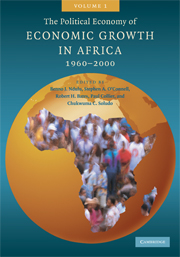Book contents
- Frontmatter
- Contents
- List of figures
- List of tables
- List of contributors
- Foreword
- List of acronyms
- PART 1 OVERVIEW
- 1 Policy plus: African growth performance, 1960–2000
- 2 Opportunities and choices
- 3 Anti-growth syndromes in Africa: a synthesis of the case studies
- PART 2 INTERPRETATION
- PART 3 EXPLANATION
- PART 4 LOOKING AHEAD
- Index
- References
1 - Policy plus: African growth performance, 1960–2000
Published online by Cambridge University Press: 09 January 2010
- Frontmatter
- Contents
- List of figures
- List of tables
- List of contributors
- Foreword
- List of acronyms
- PART 1 OVERVIEW
- 1 Policy plus: African growth performance, 1960–2000
- 2 Opportunities and choices
- 3 Anti-growth syndromes in Africa: a synthesis of the case studies
- PART 2 INTERPRETATION
- PART 3 EXPLANATION
- PART 4 LOOKING AHEAD
- Index
- References
Summary
Overview
A collaborative effort of the African Economic Research Consortium (AERC), Harvard University, and Oxford University, the Growth Project was designed to produce the first comprehensive assessment by African research economists of the growth experience of Sub-Saharan Africa (SSA) in the post-independence period. At the core of the project is a tight integration of country-level research with global econometric evidence on economic growth. In this chapter we provide the building blocks of this approach and a perspective on the lessons it produced. The themes introduced here are developed in detail throughout this volume and in the accompanying volume 2 of country studies. In the course of our analysis we provide a road map to the remaining chapters of this synthesis volume.
Economic growth in Africa, 1960–2000
Africa's growth record appears in table 1.1, which focuses on the period from 1960 to 2000 and applies to all developing countries with continuous data. The post-1960 period corresponds closely to the era of political sovereignty in SSA (table 1.2). It is also by far the most intensively studied period in the global growth econometrics literature, reflecting the availability of comparable cross-country data on the contemporary nation-states of the developing world.
Simple cross-country averages suggest, at best, a story of modest progress. Human development indicators (HDIs) showed a decided improvement over the forty-year period, and real GDP per capita rose by 60 percent.
But, on a deeper look, the record is profoundly unsettling.
- Type
- Chapter
- Information
- Publisher: Cambridge University PressPrint publication year: 2007
References
- 17
- Cited by



